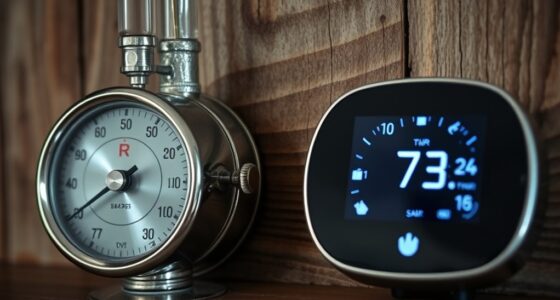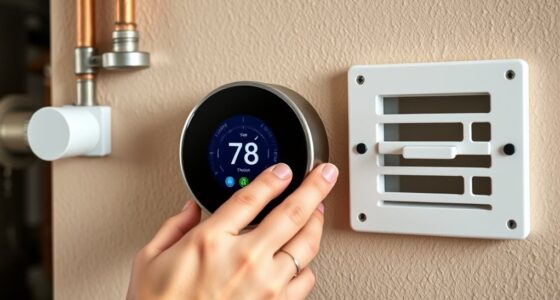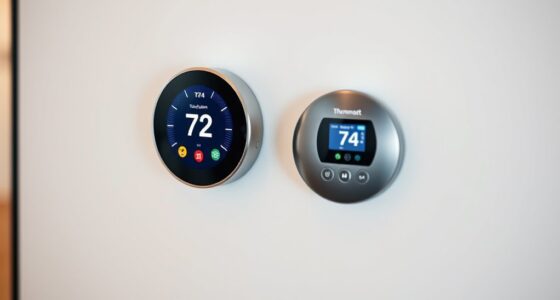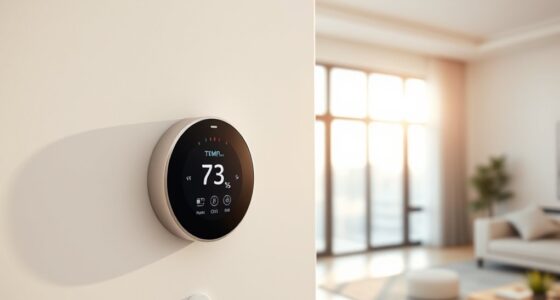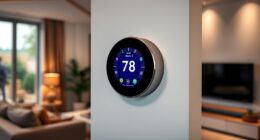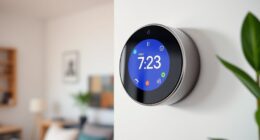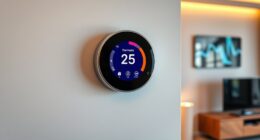The future of thermostats involves predictive climate control that seamlessly learns your routines, senses your environment, and adjusts settings proactively. These smart systems connect with your home’s devices, using advanced sensors and machine learning to optimize comfort while reducing energy use. They analyze weather, occupancy, and habits to make real-time adjustments. As you explore further, you’ll discover how these innovations create more efficient, comfortable homes tailored to your lifestyle.
Key Takeaways
- Future thermostats will leverage AI and machine learning for proactive climate adjustments based on user habits and environmental data.
- Integration with smart home ecosystems will enable seamless coordination among devices for optimal comfort and efficiency.
- Advanced sensors and predictive analytics will allow thermostats to anticipate needs before users manually set preferences.
- Energy conservation will be enhanced through weather forecasts, occupancy detection, and renewable energy integration.
- User interfaces will become more intuitive with voice commands and smart apps, making control effortless and more personalized.
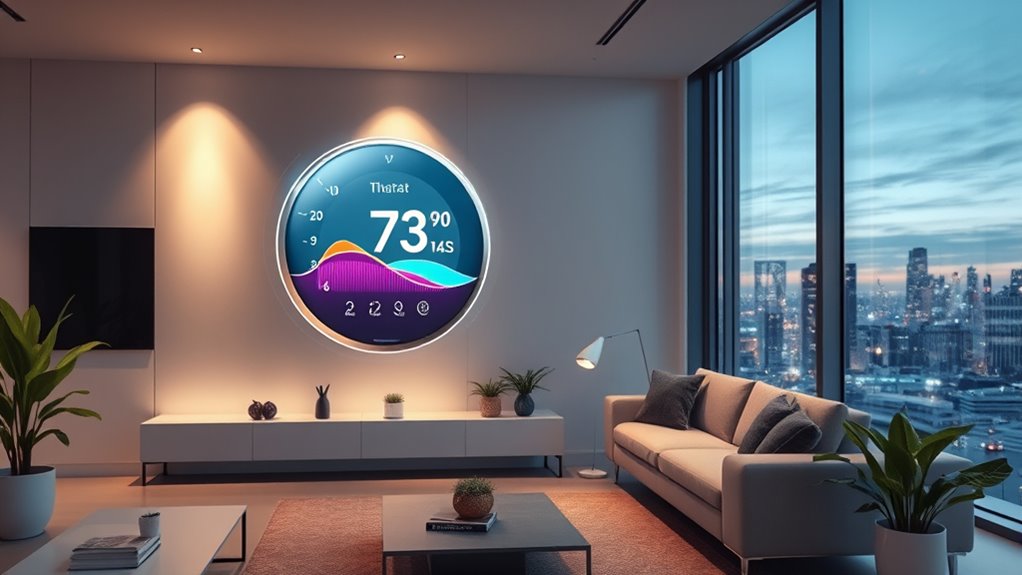
Have you ever wondered how thermostats will evolve in the coming years? The answer lies in smart integration and a focus on energy efficiency. Future thermostats won’t just be devices that turn your heating or cooling on and off; they’ll become intelligent systems that seamlessly connect with your entire home ecosystem. Imagine a thermostat that learns your daily routines, detects your presence, and adjusts the temperature proactively to maximize comfort and conserve energy. This level of smart integration means your thermostat communicates with other smart devices—like your lighting, blinds, and even your appliances—to create an optimized living environment that responds dynamically to your needs.
Smart thermostats will learn your routines, connect with devices, and optimize comfort and energy efficiency seamlessly.
By leveraging advanced sensors and machine learning algorithms, these next-generation thermostats can predict your preferences before you even realize them yourself. For instance, if you usually lower the temperature during the evening, the thermostat will recognize this pattern and make the adjustment automatically, ensuring you’re never uncomfortable or wasting energy. This predictive climate control not only enhances your comfort but also markedly improves energy efficiency. When your system is tuned to operate only when needed, it reduces unnecessary energy consumption, leading to lower utility bills and a smaller carbon footprint. Additionally, integrating renewable energy sources into these systems can further enhance their sustainability. Moreover, incorporating user data analysis helps refine the system’s ability to adapt to changing habits over time.
Energy efficiency is at the core of these innovations. Future thermostats will be designed to analyze data from weather forecasts, occupancy patterns, and your personal habits, adjusting heating and cooling schedules accordingly. This intelligent adaptation means your home stays comfortable without overworking your HVAC system. Plus, with the integration of renewable energy sources and smart grid technology, these thermostats can coordinate with external energy supplies, further optimizing usage and reducing waste.
The shift toward smart, efficient thermostats also involves user-friendly interfaces that make control simple and intuitive. Whether you’re adjusting settings via voice commands, smartphone apps, or through automation, you’ll find managing your climate environment easier than ever. The integration of heat pump technology into these systems can further enhance their efficiency, especially in moderate climates where heat pumps operate optimally. The goal is to make these devices so intelligent and interconnected that they operate invisibly in the background, maintaining ideal conditions while you focus on other things.
In essence, the future of thermostats is about creating a smarter, more energy-conscious home. By combining smart integration with a commitment to energy efficiency, these devices will revolutionize how you experience comfort and sustainability in your living space. As technology advances, your thermostat will do more than just regulate temperature—it will become an essential part of your home’s intelligent ecosystem, working tirelessly behind the scenes to keep your environment perfect while conserving resources.
Frequently Asked Questions
How Will Predictive Thermostats Impact Energy Bills Long-Term?
Predictive thermostats will substantially impact your energy bills over the long term by enhancing energy savings and improving cost efficiency. They learn your schedule and preferences, adjusting settings automatically to optimize comfort while reducing unnecessary energy use. As a result, you’ll notice lower utility costs and a more efficient home environment. Over time, these smart devices help you save money while maintaining a comfortable living space, making them a smart investment.
Are Predictive Thermostats Compatible With Existing Smart Home Systems?
Imagine you’re stepping into your smart home back in the 90s—futuristic, right? Predictive thermostats often seamlessly integrate with existing smart home systems, thanks to advances in device compatibility and smart home integration. Most models support popular platforms like Alexa, Google Home, or Apple HomeKit. However, compatibility can vary, so you’ll want to verify your thermostat’s specifications before purchasing to ensure it syncs smoothly with your current setup.
What Security Risks Are Associated With Predictive Climate Control Devices?
You should be aware that predictive climate control devices pose security risks like data breaches and unauthorized access. Since these devices collect personal data to optimize your environment, hackers could exploit vulnerabilities to access sensitive information or control your system. To protect yourself, make sure your devices have strong passwords, keep firmware updated, and use secure Wi-Fi networks. Staying vigilant helps prevent potential security breaches and unauthorized access.
How Accurate Are Predictive Thermostats in Extreme Weather Conditions?
A stitch in time saves nine, and when it comes to predictive thermostats, their accuracy depends on sensor precision and weather adaptability. In extreme weather, you might notice fluctuations if sensor accuracy dips or if the device struggles with rapid climate shifts. While these thermostats are generally reliable, their performance can vary, so it’s wise to observe how well they adapt to sudden temperature changes to ensure consistent comfort.
Will Predictive Thermostats Require Regular Software Updates or Maintenance?
Predictive thermostats will need regular software updates to stay accurate and secure. You should expect to perform device maintenance periodically, such as checking for updates and ensuring the system functions properly. These updates often improve performance and fix bugs, helping your thermostat adapt to changing weather patterns. Staying on top of software updates keeps your device running smoothly and guarantees it continues to provide reliable climate control.
Conclusion
As you embrace the future of thermostats with predictive climate control, you’re stepping into a smarter, more efficient home. With technology that learns your habits and adjusts accordingly, why settle for outdated systems? Imagine a world where your comfort is effortlessly maintained and energy is conserved. Are you ready to upgrade to a smarter way of living? The future is here—are you prepared to make your home more intelligent and sustainable?


